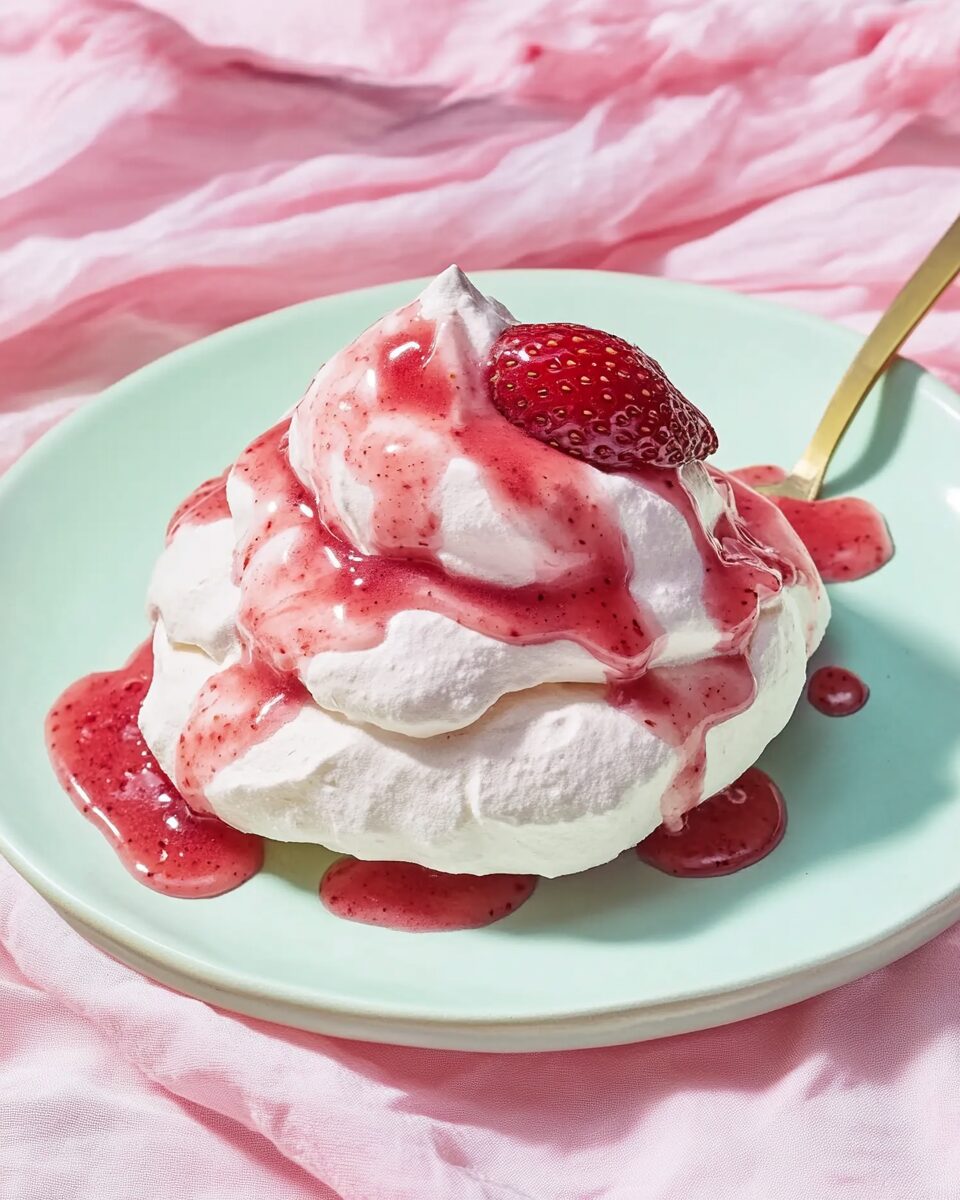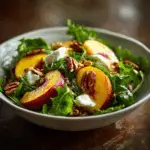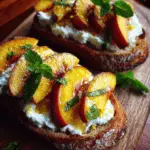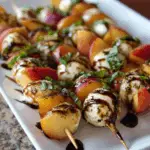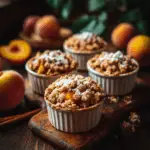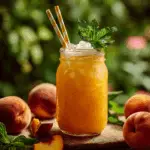Delight in the harmonious blend of crisp meringue, tangy rhubarb, and sweet strawberries with these Mini Strawberry Rhubarb Pavlovas. This elegant dessert offers a perfect balance of textures and flavors, making it an ideal choice for spring gatherings or special occasions.
FULL RECIPE
Ingredients:
1.Meringues:
- 1/2 cup (100 grams) granulated sugar
- 1/2 teaspoon (1.25 grams) cornstarch
- 2 large egg whites (approximately 70 grams)
- 1/4 teaspoon (1 gram) kosher salt
- 1/2 teaspoon (2.5 milliliters) vanilla extract
2.Toppings:
- 1 cup quartered fresh strawberries
- 1 cup chopped fresh rhubarb
- 2 tablespoons (30 milliliters) dry white wine or water
- 1/4 cup plus 1 tablespoon (62.5 grams) granulated sugar, divided
- 1 cup (250 milliliters) heavy cream (35%)
- 1 teaspoon (5 milliliters) vanilla extract
- 2 tablespoons toasted slivered almonds
Directions:
Prepare the Meringues:
- Preheat the oven to 250°F (120°C). Line a baking sheet with parchment paper.
- In a small bowl, mix together the sugar and cornstarch; set aside.
- In a clean metal, glass, or ceramic bowl, add the egg whites and salt. Using a hand mixer, beat on high speed until soft, foamy peaks form.
- Gradually sprinkle in the sugar mixture while continuing to beat until the meringue is glossy and holds stiff peaks.
- Gently fold in the vanilla extract.
- Spoon the meringue onto the prepared baking sheet, forming four equal-sized nests.
- Bake for 1 hour, then turn off the oven and allow the meringues to cool completely inside the oven.
Prepare the Fruit Topping:
- In a small saucepan over medium-low heat, combine the strawberries, rhubarb, wine (or water), and 1/4 cup (50 grams) of sugar.
- Cook for 10 to 15 minutes, stirring occasionally, until the fruit softens and the mixture becomes jam-like.
- Remove from heat and let cool to room temperature. Refrigerate until ready to use.
Assemble the Pavlovas:
- In a chilled bowl, whip the heavy cream with the remaining 1 tablespoon (12.5 grams) of sugar and vanilla extract until soft peaks form.
- Place each meringue nest on a serving plate.
- Top each meringue with a dollop of whipped cream, followed by a spoonful of the strawberry-rhubarb mixture.
- Garnish with toasted slivered almonds.
Nutrition Facts
- Calories: 437
- Total Fat: 25 g
- Saturated Fat: 15 g
- Carbohydrates: 48 g
- Dietary Fiber: 2 g
- Sugars: 45 g
- Protein: 5 g
- Cholesterol: 71 mg
- Sodium: 146 mg
The History of Pavlova
Pavlova is a beloved dessert with origins disputed between Australia and New Zealand. Named after the Russian ballerina Anna Pavlova, it is said to have been created in her honor during her tour of the region in the 1920s. The dessert features a light and airy meringue base, crisp on the outside and soft on the inside. Over the years, pavlova has evolved into various versions, incorporating different fruit toppings, creams, and syrups to enhance its flavor profile.
Why Strawberry and Rhubarb Make a Perfect Pair
Strawberry and rhubarb are a classic combination in many desserts due to their complementary flavors. The natural sweetness of strawberries balances the tart, slightly sour taste of rhubarb, creating a dynamic contrast that enhances the overall taste. This pairing is often used in pies, crumbles, and compotes, making it an excellent choice for pavlova, where the balance between sweetness and acidity adds depth to the dish.
The Science Behind Meringue
Meringue is a key component of pavlova, made by whipping egg whites with sugar until stiff peaks form. The process works by incorporating air into the egg whites, which are stabilized by sugar. The addition of cornstarch in this recipe helps maintain the soft interior of the pavlova, while the slow baking process at a low temperature ensures a crispy exterior without browning. The science of meringue is precise, requiring dry conditions and careful handling to achieve the perfect texture.
How to Get the Perfect Meringue Texture
Achieving the ideal meringue texture requires patience and technique. The egg whites must be whipped at the right speed to incorporate air gradually, preventing overbeating, which can cause the mixture to collapse. Adding sugar slowly helps stabilize the meringue, and using fresh, room-temperature eggs results in better volume. Baking at a low temperature prevents cracking, and cooling the pavlova inside the oven ensures it sets properly without deflating.
The Role of Cornstarch in Pavlova
Cornstarch is a crucial ingredient in pavlova, helping to create the signature marshmallow-like center. It prevents the meringue from becoming too brittle by absorbing excess moisture, ensuring the interior remains soft. Without cornstarch, pavlova may turn out too crisp, losing the desired contrast between the crunchy exterior and the light, airy inside.
Why Pavlova Is a Popular Dessert for Special Occasions
Pavlova is a show-stopping dessert that is often served during celebrations, holidays, and gatherings. Its elegant appearance, light texture, and customizable toppings make it a favorite for festive occasions. It is particularly popular during the spring and summer months when fresh berries are in season, adding natural sweetness and vibrant colors to the dish.
The Best Types of Rhubarb for Desserts
There are several varieties of rhubarb, each with unique characteristics. The most common type used in desserts is the red-stemmed variety, which has a sweeter, milder flavor compared to the green-stemmed types. When selecting rhubarb, look for firm stalks with bright red hues, as these tend to have a richer flavor and work best in sweet recipes.
The Importance of Whipped Cream in Pavlova
Whipped cream adds a layer of richness to pavlova, balancing the crisp meringue and tangy fruit topping. Using heavy cream with at least 35% fat ensures a stable, fluffy texture. Sweetening the whipped cream lightly allows the natural flavors of the strawberries and rhubarb to shine, creating a well-rounded dessert experience.
The Art of Toasting Almonds for Garnish
Toasted almonds provide a delightful crunch and nutty flavor that enhances the pavlova. Toasting brings out the natural oils in the almonds, deepening their flavor. To achieve an even golden brown color, almonds should be toasted in a dry pan over low heat or in an oven for a few minutes, stirring occasionally to prevent burning.
How to Store Pavlova Properly
Pavlova is best enjoyed fresh, but it can be stored properly to maintain its texture. The meringue base should be kept in an airtight container at room temperature to prevent moisture absorption, which can cause it to become chewy. If the pavlova is already assembled with toppings, it should be stored in the refrigerator and consumed within a day to prevent sogginess.
Can Pavlova Be Made Ahead of Time?
Yes, pavlova can be partially prepared in advance. The meringue can be baked a day ahead and stored in a dry place. However, the toppings should only be added just before serving to maintain the crisp texture of the meringue. If making whipped cream ahead of time, storing it in an airtight container in the refrigerator will help keep it fresh.
Common Mistakes to Avoid When Making Pavlova
There are several mistakes that can affect the outcome of pavlova. Overbeating egg whites can cause them to break down, resulting in a grainy texture. Adding sugar too quickly prevents proper aeration, leading to a dense meringue. Baking at too high a temperature can cause cracks, while humidity can make the pavlova sticky. Proper technique and patience are key to achieving the perfect pavlova.
Alternative Toppings for Pavlova
While strawberry and rhubarb are a classic combination, pavlova can be topped with various other fruits and sauces. Passion fruit, mango, kiwi, and mixed berries are excellent alternatives. Chocolate shavings, caramel sauce, and citrus curds can also be added for a unique twist. The versatility of pavlova allows for endless variations to suit different tastes.
The Best Wine Pairings for Pavlova
Pavlova pairs well with light, sweet wines that complement its delicate flavors. A Moscato d’Asti, with its floral notes and slight effervescence, enhances the fruity toppings. Late-harvest Riesling or a sparkling rosé also work well, as their acidity balances the sweetness of the meringue and cream.
How to Serve Pavlova for Maximum Visual Appeal
Presentation is key when serving pavlova. Arranging the fruit toppings in a decorative pattern enhances its aesthetic appeal. Drizzling a light syrup or sauce over the top adds elegance. Serving pavlova on a white platter allows the colors of the fruit to stand out, creating a visually stunning dessert that is sure to impress.
The Role of Acidity in Balancing the Flavors of Pavlova
Acidity plays a crucial role in pavlova, preventing it from becoming overwhelmingly sweet. The tartness of rhubarb cuts through the richness of the meringue and whipped cream, creating a well-balanced flavor profile. Incorporating citrus juice or zest in the topping can further enhance this balance.
How Weather Affects Meringue
Humidity is a major factor when making meringue. High moisture levels in the air can cause the meringue to become sticky or collapse. On rainy or humid days, it is best to prepare pavlova in an air-conditioned environment or wait for drier conditions to achieve the best results.
Pavlova as a Gluten-Free Dessert Option
Pavlova is naturally gluten-free, making it an excellent dessert choice for those with gluten sensitivities. Unlike traditional cakes and pastries, which rely on flour for structure, pavlova is made with egg whites and sugar, allowing it to be enjoyed by a wider range of people with dietary restrictions.
Conclusion
Mini Strawberry Rhubarb Pavlovas are a delightful dessert that combines the crispness of meringue with the tangy-sweet flavors of fresh fruit. The contrast in textures and flavors makes each bite a perfect balance of lightness and indulgence. Whether served at a formal gathering or a casual summer picnic, this dessert never fails to impress. With proper preparation and attention to detail, anyone can master the art of making pavlova, creating a stunning and delicious treat that is sure to be a favorite.

